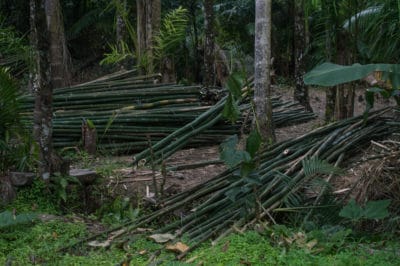Running vs. Clumping Bamboo
Before taking a sharp object to your bamboo, it’s important to consider what kind of bamboo you have. Running bamboos spread via underground rhizomes. A clump of bamboos all arise from a single rhizome mass and can spread very quickly. Clumping bamboo spreads differently and more slowly. These differences affect how and when you cut the culms.
Tools for Cutting Bamboo
The most important aspect of any bamboo cutting tool is that it must be able to take a sharp edge. Heavy steel is often the best choice, as bamboo culms and rhizomes are tough, and the steel will hold an edge well. Sharp pruning shears can be used on slender stalks, but a chainsaw may be best for larger culms. A fine-bladed hacksaw is a good choice for cutting poles.
Cutting Bamboo Poles
Bamboo is useful for poles in the garden or for projects like trellises. To cut bamboo poles:
- Score the bamboo along a penciled line with a sharp knife.
- Clamp in a vise or otherwise stabilize the pole.
- Saw gently along the scored line with a sharp, fine-bladed hacksaw; use a miter box for angled cuts.
- Sand gently with fine sandpaper to smooth rough spots.
Pruning Culms
A bamboo culm, or stalk, grows in length by filling its cells with water. Culms don’t grow in diameter. Once cut, a culm will not regrow. Plan your cuts ahead of time and always cut as close to the ground as possible to avoid leaving unattractive stubs. The cut should be horizontal, unlike the slanted cuts often recommended for trees.
Cutting Rhizomes
Running bamboos need regular root pruning to keep them contained. Dig a one-foot deep trench around the entire perimeter. Use a heavy, sharp, straight-bladed shovel to cut straight down through the root. A tool called a bamboo slammer, which looks like a heavier version of a lawn edging tool, is useful for cutting through a root mass when dividing plants.
Cutting Branches and Leaves
Cut branches as close to the culm as possible, using a sharp knife, pruning shears or clippers. Once cut, the branches will not grow back. However, a branch below the node you’ve cut will continue to grow. Leaf edges and tips should not be trimmed, but the entire leaf can be cut off close to the branch.
